Nothing says summer like large clusters of bright hydrangeas, with blossoms that last for months. From the early spring until autumn, hydrangeas delight gardeners across the country.
One big reason hydrangeas are so beloved? They add the critical elements of texture and color to your landscape at the same time. The fluffy, vibrant clusters of blooms make this plant a favorite of professional landscape architects and home gardeners alike.
Best of all, you don’t need a green thumb to ensure your hydrangeas thrive. Follow this simple hydrangea guide for months of blooms:

Choosing the Right Hydrangea
When choosing hydrangeas for your landscape, there are a few considerations you should keep in mind, including color, size, shape, growing zone and bloom type.
Hydrangea color
Consider the color you want to add to your landscape. With blossoms ranging from whites, greens and pinks to blues and purples, each color can make a dramatic change in your landscape. Be sure to choose the hydrangeas that will fit in best with your existing plants.
Hydrangea size
Also take into account the mature size of your hydrangeas. Some only grow to about 2 to 3 feet tall and wide, while others grow up to 6 feet tall with a 6 foot spread. Smaller hydrangea varieties are perfect for compact garden beds, patio pots and areas with limited space. They also require less pruning and upkeep, because they won’t overgrow their planting area. However, if you're looking to fill a large landscape area or create a hedge of hydrangeas, larger varieties will work well.
Hydrangea shape
When it comes to shape, consider whether you want a more natural, organic look, or a more manicured one. Hydrangeas will grow naturally into a lush shrub, while some are trained to grow in tree form. Tree-form hydrangeas have a single trunk that leads up to a ball of lush green leaves with large flower clusters. Hydrangea trees can make a bold statement as accent pieces in the garden and in containers framing entryways. You can even get climbing hydrangea vines that will cover trellises, patio walls or other structures!
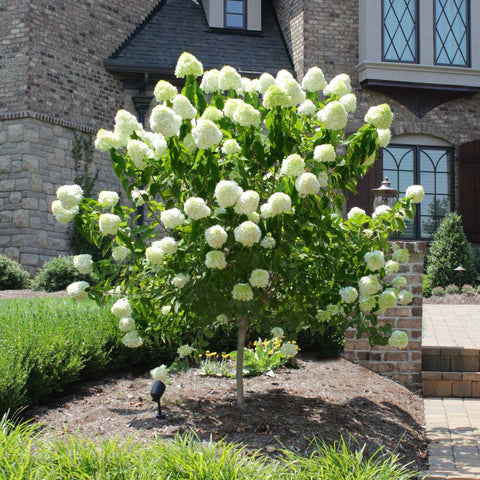
Hydrangea growing zones
Don't forget about your growing zone! While some hydrangeas are extremely cold hardy and thrive in the harsh winter conditions up to zone 4, other hydrangeas are only cold hardy to growing zone 6. There are even types of hydrangeas that are only cold hardy to growing zone 8. With a range of options for hydrangea shrubs, it's easy to find one that will grow where you live.
If the hydrangea that you really want isn’t cold hardy enough for your growing zone, you can always plant it in a container and bring it indoors during colder months. Hydrangeas thrive in containers and look great on porches, decks and patios.
Types of hydrangea flowers
And consider the flower type you want to see on your hydrangeas. Mophead hydrangeas, one of the most popular varieties, have signature large, round flowers that densely cover the plant. Panicle hydrangeas have longer, cone-shaped flowers, for an incredibly unique look. Lacecap hydrangeas, another variety, feature flowers with a center of small buds, encircled with large petals.

Hydrangeas: Planting and Care
Hydrangeas are an incredibly low-maintenance shrub, but there are a few tips for planting and care that will ensure your hydrangeas thrive.
When you’re deciding where to plant your hydrangeas, select a location that receives full to partial sunlight. An area that receives sun in the morning and shade in the afternoon will be best. Hydrangeas also thrive in dappled shade.
Dig a hole twice as big as the root mass and just as deep. Carefully remove any debris like grass, dirt clumps and rocks from the hole. Use a pitchfork or shovel to loosen the soil around the hole. Next, place your hydrangea in the hole and make sure that it’s level with the surrounding ground before gently backfilling the soil.
After the planting process is complete, give your hydrangea a long drink of water, until the soil becomes moist but not oversaturated. Pay attention to the amount of rain in your area, because hydrangeas need an inch of water a week. If it hasn’t rained, supplement with the hose. Hydrangeas love water, so make sure the soil stays moist.
When you’re planting hydrangeas in a container, ensure you use a large pot and that the bottom of your pot has drainage holes.
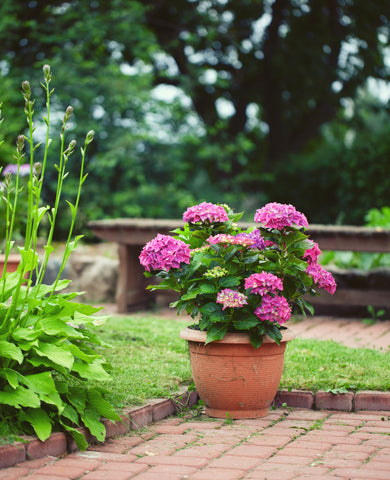
While hydrangeas often don’t require fertilizer to see amazing blooms, they will still benefit from a nutritious boost. Fertilize your hydrangeas once in the early spring and again in the late summer with a well balanced formula like 6-6-6 or 8-8-8. Blue hydrangea varieties in particular prefer fertilizer that’s more acidic - look for a fertilizer formulated for acid-loving shrubs, or a formula with a 30-10-10 blend.
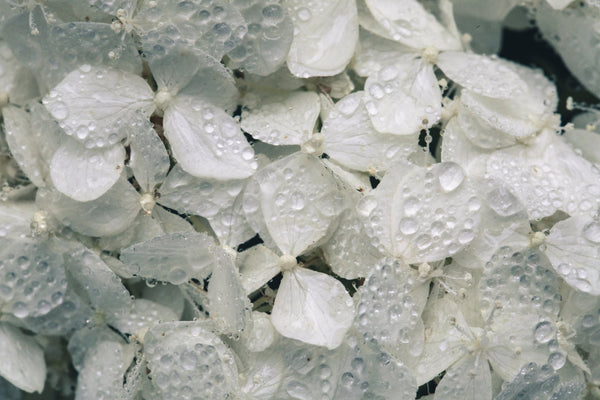
Pruning Hydrangeas
If you need to prune your hydrangeas for shape or to prevent them from growing too large, it’s best to prune them in the midsummer, once their blooms start to fade.
Use a sterile pair of hand pruners or loppers and make your cuts at 45-degree angles facing upwards to promote new growth. Make your cuts directly below the clusters of faded flowers, and cut older or dead canes back to the ground. Also, remove any crisscrossing or damaged stems.
How to Change Your Hydrangea's Colors
The bloom color isn’t set on all hydrangea varieties, and can often be changed from blue to purple to pink and even red, just depending on the soil conditions!
It’s incredibly simple to change the bloom hues - whether you want your hydrangeas to fit into your landscape better or just change color for variety.
For example, the Nikko Blue Hydrangea and Endless Summer Hydrangea will have deep blue blooms if their soil’s pH is kept around 5.5. For pink to red blossoms, raise the pH of the soil to around 7.0 or higher. Add lime to your soil to raise the pH, and sulfur to lower it. You can test the pH balance of your soil with a pH meter found at your local gardening store.
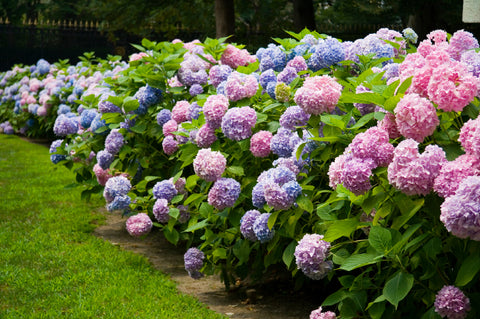
How to Keep Cut Hydrangeas from Wilting
You can clip hydrangea flowers all summer to place in vases around your home. The perfect centerpiece on tabletops, or a bedroom accent with a burst of color? Check.
However, without the right care, hydrangeas can wilt soon after cutting. To prevent your flowers from wilting, pick them in the morning, before they get hot in the summer sun. When cutting, choose the older, more mature blooms, as they are less sensitive. Remove the leaves before arranging, since they will steal water from the blossoms.
Before placing your hydrangea stems into a vase, boil water and stick the end of each stem into it. This will clear out any sap at the end of the stems that can clog them and prevent water from traveling up to the flowers. Then, immediately place your hydrangeas in a vase filled with room temperature water. Change the water on a daily basis to keep flowers fresh and bright.
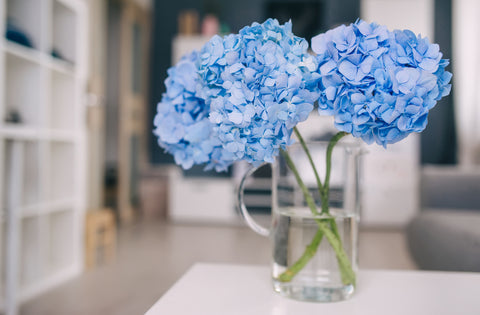
Color for Summer and Beyond
With warmer weather on the way, there's plenty of time to enjoy our backyards and patios on the horizon. Enhance your landscape and make it even more enjoyable, with beautiful hydrangeas that bloom for months and provide a sweet floral scent.
These shrubs and trees couldn't be easier to grow and maintain - and with so many varieties, shapes and colors, you're sure to find one (or more!) that fit perfectly into your landscape.





